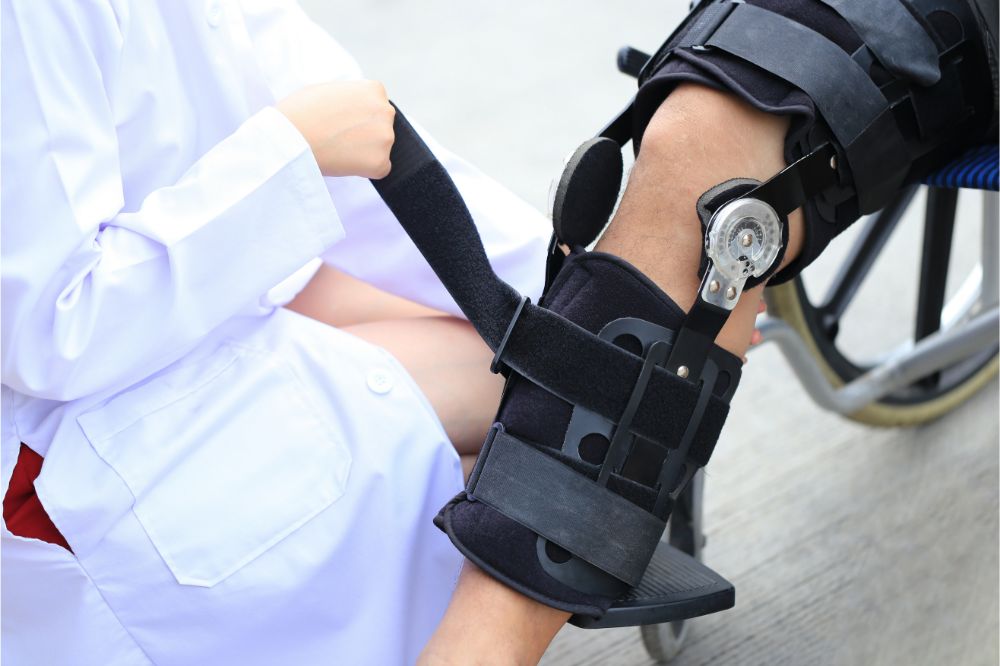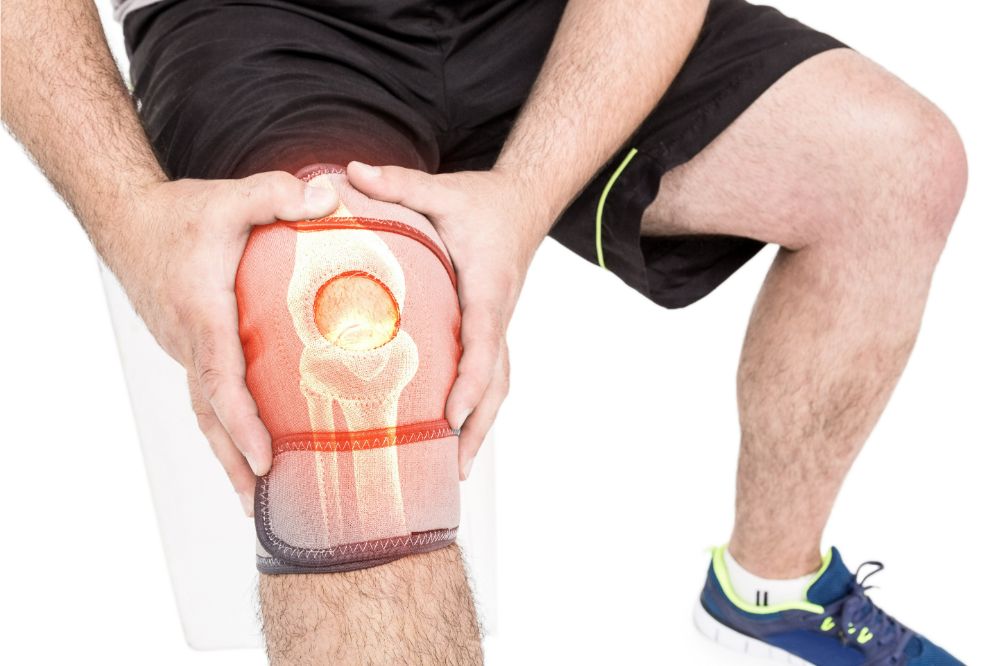A knee brace is one of the most common aids used in physical therapy. It is used to help treat all sorts of knee injuries and ailments, from sports accidents to work-related trauma.
Aside from ACL injury and fractures, the next most typical cause of knee pain is torn meniscus.
If you suffer from this condition, you’ve probably considered different kinds of knee aids.
Will a knee brace help torn meniscus in the first place? Let’s find out.

What Is a Torn Meniscus?
If you look at any detailed illustration of a knee, you will see a thin pad right below the patella or the kneecap.
It functions as a cushion between the femur (thigh bone) and the tibia (shin bone). From the top view, this pad is shaped like a C.
The main function of this cartilage is to provide lubrication to the knee’s range of motion. It also absorbs shock and distributes the axial load that your knee receives.
Unfortunately, this cartilage is soft, which means extreme force or abrupt movements can lead to meniscal tears.
When this happens, you will experience extreme pain, stiffness, and even swelling in the affected knee.
Its range of motion will also be limited, and you may find it difficult to extend your leg fully.
What Causes Torn Meniscus?
A torn meniscus is a common knee injury that often occurs in contact sports like basketball, football, or soccer.
Meniscus injuries only happen when the foot is planted on the ground, so heavy daily activities may also lead to this injury.
Basically, a torn meniscus occurs when a person forcefully rotates or twists their knee.
The aggressive pivoting, sudden turning, and abrupt stopping can cause the meniscus to overstretch.
That said, everyday activities can still lead to this type of tear, especially if the person is getting old or is suffering from arthritis.
The degeneration of the cartilage makes it weaker to withstand even low-impact and normal activities.
A torn meniscus may also result from losing balance after a high jump or stepping on an uneven surface.
What Are the Symptoms of Torn Meniscus?
The symptoms of a torn meniscus vary from one person to another. In some cases, the person suffers a minor tear with the meniscus still connected to the knee.
On the other hand, some accidents cause the meniscus to detach from the entire knee joint or only stay attached by a cartilage thread.
Whichever the case, here are some of the most common symptoms of a torn meniscus:
- Any level of pain when extending the knee
- Swelling
- stiffness
- Knee locks or clicks
- Inability to keep the knee stable
- Difficulty walking or moving the leg
How Is Torn Meniscus Diagnosed?
Aside from the symptoms we listed, some procedures can confirm or diagnose a torn meniscus, including:
Physical Exam
In a physical exam, a doctor or a physical therapist will test your range of motion and closely inspect the area where the meniscus is.
The doctor may also conduct a McMurray test, which involves bending, extending, and rotating your knee.
In this test, you might hear a pop indicating a torn meniscus.
X-Ray
An x-ray allows doctors to use electromagnetic beams to create images of tissues, bones, cartilage, and organs.
Focusing this procedure on your knee will help diagnose a torn meniscus properly.
MRI
An MRI uses radiofrequency and large magnets to produce images of the internal parts of your body.
The result almost looks like an x-ray, but MRI provides more detailed illustrations of your body parts.
Arthroscopy
Arthroscopy is a more invasive diagnostic method compared to the other three we just listed. It is almost exclusively reserved for severe cases of joint injuries.
It uses an optic tube inserted into your body through a small incision. The optic tube includes a tiny camera at the end, which projects the images it captures on a computer screen.
The upside to this is that it provides a more definitive diagnosis of the injury, which will also give insights into how to treat it.
Will a Knee Brace Help Torn Meniscus?
Once you’ve determined or been diagnosed with a torn meniscus, you need to undergo proper treatment.
Aside from physical therapy, a knee sleeve or brace may also be crucial for this common injury.
In most cases, the injury heals on its own in a matter of months.

Still, wearing a knee brace should help speed up the healing of your torn meniscus through the following benefits:
Stability
You might think that a tear in this cruciate ligament is all you have to worry about. In truth, when you suffer from a torn meniscus, you compromise your overall stability.
As a result, you may overcompensate by overusing or overstretching your other muscles and body parts. It can lead to another injury.
A rigid knee brace, like the United Ortho Knee Immobilizer, will help maintain your stability and prevent you from aggravating the injury further through constant use.
On the other hand, hinged knee braces protect both sides of the injured knee, which helps reduce the wobbliness of your legs after an injury.
Avoids Hyperextension
Hyperextension of the knee is one of the most common causes of a meniscus tear.
All braces for meniscus tears, whether they be rigid or soft knee braces, help prevent this after the injury.
It means that your knee’s range of motion is below normal, preventing you from damaging the meniscus even more.
A rigid or hinged brace may even avoid forceful twisting of the knee.
Increased Confidence
Some of the worse types of meniscus tears can be so painful that the patient may feel intimidated even to use the injured knee.
However, rehabilitative exercises with a healthcare professional are vital in restoring its function.
A supportive brace on the knee does not only help heal the body but also the mind. It provides the confidence necessary to undergo physical therapy and get back on the road to recovery.
Pain Relief
This benefit is mostly from unloader knee braces. This type of knee brace unloads the weight your meniscus receives from your upper leg.
It absorbs some of it and distributes the rest to your lower leg.
Since there is less load on your knee during recovery, it heals faster while relieving you of the pain.
The pain relief may even help you conduct your favorite activities with ease. Check out the BraceAbility Unloader Knee Brace if you’re looking for one.
Better Circulation
Quality knee braces provide just enough pressure to the affected area to improve blood flow.
When you combine this with low-impact exercise, you increase the blood flowing to your knee.
The improved circulation provides oxygen and nutrients to the injury, which are vital to speed up recovery.
Additionally, knee braces or compression sleeves reduce inflammation and soreness.
This allows you to stick to your physical therapy program, especially after your muscles adapt to the rehabilitative exercises you perform regularly.
Avoid Surgery
As soon as you experience pain in the knee, it is best to have it checked by a physical therapist immediately.
If it is a minor tear, a brace for meniscus tears may be enough to treat it. Otherwise, continuing to use the affected knee may worsen the tear.
If not addressed properly and immediately, severe meniscus tears may require surgery.
Knee Braces For a Torn Meniscus
When you suffer from a torn meniscus, you shouldn’t just head to your local medical supply store and buy the first knee brace you see.
You need to understand what type of meniscus tear you have and which among the many knee braces will benefit you the most.
Here is a quick guide to help you out:
Rigid Knee Braces
Rigid knee braces are primarily responsible for completely limiting the lateral movements of your knee, which can harm your meniscus more.
They’re the most common type of knee brace athletes use because of the additional outer protection it provides.
This knee brace also allows athletes to get back to the contact sport they are involved with after they’re done with their physical rehabilitation program.
Rigid knee braces also provide the knee with a higher level of support. They’re the perfect choice for those who have torn meniscus in addition to ACL injury.
Knee Braces With Hinges
Hinged knee braces are a great choice for meniscus tears and other common knee issues like ACL, MCL, LCL, and PCL.
It offers great support to stabilize the front and sides of your knee during rehabilitation.
It also functions as a compression knee sleeve to decrease swelling, reduce pain, and promote healing.
Braces with hinges come in two forms: soft and rigid. The one you need depends on the severity of the meniscus tear.
The most important feature of this type of knee brace is that it allows you to bend and extend your knee, but only to a point where it doesn’t strain your meniscus.
It means you can still perform daily activities without harming your existing injury.
Offloader Knee Brace
We briefly tackled what an offloader knee brace is. To add, this type of knee brace is only effective in tears on one side of the meniscus.
That’s because most of the load gets transferred from one side of the meniscus to the other.
That’s also why the offloader knee brace is mostly recommended for degenerative meniscus tears.
Keep in mind that if your ACL is also torn, this type of knee brace is not your best option.
Soft Knee Brace
A soft knee brace is perhaps the most affordable option you have. It’s exclusively for minor tears that require minimal support.
Some soft braces, like the Doufurt Knee Brace, also provide compression to speed up the recovery of the tear.
Wearing a Knee Brace for a Torn Meniscus
Will a knee brace help torn meniscus? Absolutely!
However, it’s important to note that undergoing physical therapy and proper treatment is still vital for a full recovery.
Knee braces are almost always only used as an aid during rehabilitation. Nonetheless, using them will most certainly get you back on track as soon as possible.
Just make sure you get a proper diagnosis first to guarantee you get the right type of knee brace for your meniscus tear.
Read also: How Long Should I Wear a Knee Brace?